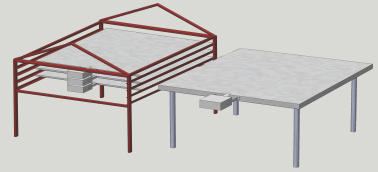Stand

Figure 1: Stand Monitor.
Stand 1cm
Stand 1cm detector comprise of three-layer assembly of 1 cm thick 1 m^2 sensitive area molded plastic scintillators one above the other and one 3 cm thick scintillator located aside (Figure 1).Detector operates in particle counter regime. Outdoors location, 1-cm thickness and three-layer design allow to measure flux of TGE electrons with 3 different energy thresholds starting from 1.5 MeV and to recover integral spectrum of TGE electrons.
Light from scintillator by optical spectrum-shifter fibers is reradiated to the long wavelength region and passed to the photomultiplier FEU-115M type photomultiplier (PM). The maximum of luminescence is emitted at a 420-nm wavelength and the luminescence time is about 2.3 ns. The tuning of the Stand 1cm detector consists in selections of PM high voltage and discrimination thresholds. The threshold should be chosen to guarantee both high efficiency of signal detection and maximal suppression of PM noise. Proper tuning of the detector provides ~99% efficiency of charged particle detection. The data acquisition system counts and stores all coincidences of the detector channels.
Coincidence ‘‘100’’ means that only the upper detector registers a particle. This combination registered low energy electrons with an efficiency of ~99% (we assume that the efficiency of electron registration in the second scintillator also is 99%). We estimate the minimal energy of an electron stopping in the upper detector and giving a signal to be ~1.4 MeV; it is the lowest energy threshold among all ASEC detectors. Gamma ray detecting efficiency of this combination is about 2%. For the coincidence 010, the gamma ray detection efficiency is increased to ~3% due to creation of electron-positron pairs in the substance of the upper scintillator. Coincidence ‘‘111’’ means that all three layers register particles; the minimal energy of charged particles giving a signal in all three layers is ~12 MeV. The energy threshold of 3cm thick scintillators is ~5MeV.
